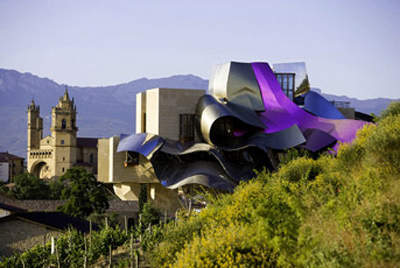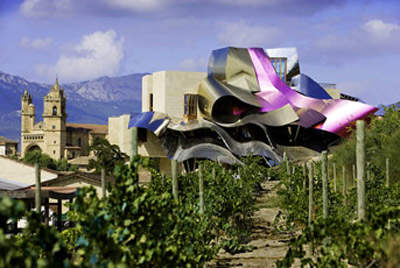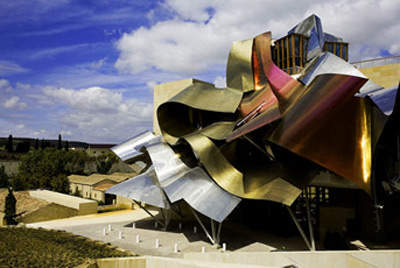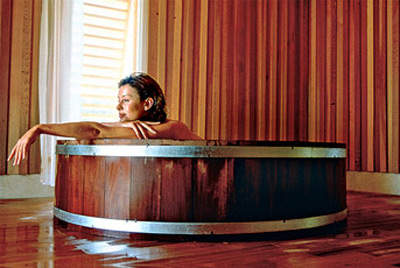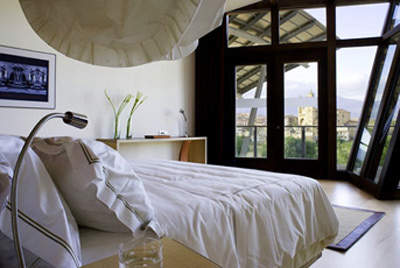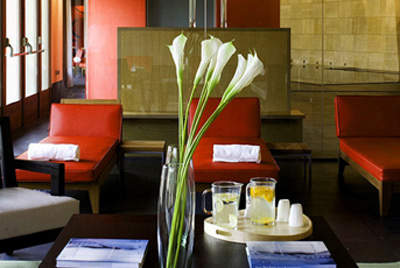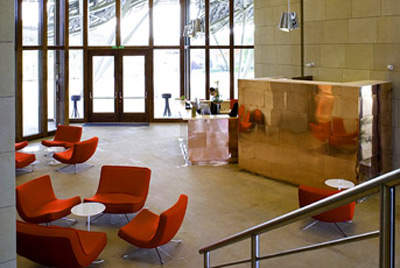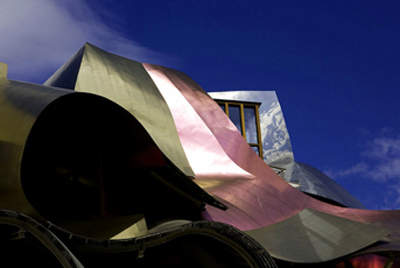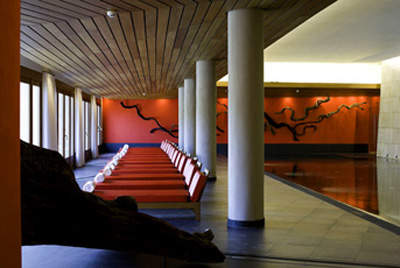In 2002 the Marqués de Riscal Winery (the oldest in the Rioja region) commissioned the celebrated architect Frank Gehry to design a hotel for their facilities in Elciego, in La Rioja, the principal wine growing region in Spain. It is an
innovative building making use of titanium and stone cladding. The hotel started construction in May 2003 and opened in July 2006.
The hotel structure is typical Gehry, looking like a bundle of metallic ribbons left by a giant in the middle of the countryside. There is no doubt that the hotel building is architecturally significant but the inside has fixtures, fittings and
services to match. The hotel required an investment of €60m to construct and outfit to the required luxury standards.
FACILITIES
The hotel has 43 exclusively furnished suites, all of which have been individually designed with a view of the surrounding vineyard and the town of Elciegio. Each of the suites features a modern, comfortable atmosphere and unique design by Frank
Gehry. All are equipped with luxuries such as LCD TV, CD player, coffee/tea maker, marble bathrooms and high speed internet access (ADSL and wireless). The main restaurant combines traditional Rioja cuisine with modern influences by the well-known
Echaurren Restaurant (1 Michelin star).
In addition, there is a wine bar in a more informal setting, a rooftop bar and lounge with panoramic views and open fireplace, a wine tasting corner, cooking school, and an ancient wine cellar, which has been converted to a banqueting hall. The
leisure facilities are headed by the Caudalie Vinothérapie Spa that offers an indoor swimming pool, hammam (steam therapy), fitness, and a wide variety of massages and treatments featuring ‘wine therapy’.
Guests also have access to the Marqués de Riscal vineyards, the Wine Museum and shop, and the state-of-the-art process and elaboration centre. Additional leisure activities in the area include two golf courses, tours of the surrounding nature
and hills by foot, bike, or horse, and ‘Ruta de Vino’, an established tour which explores the Rioja wine region by car.
HOTEL DESIGN
In the design of the hotel Gehry has explored a new facet of the material used to dramatic effect in the Guggenheim Museum he designed in Bilbao (1991–1997). The main structure is wrapped in a series of flowing coloured titanium canopies
supported directly off the hotel building of natural-coloured stone and from the ground on slender steel sections. These provide shade from the intense Rioja sun.
The bold structure, which would at first seem to be out of place, is actually a response to the unbroken landscape of lush vineyards surrounding the building, while the hues of the coloured metal are inspired by the rich tones of the sky and vineyard.
The rosé, silver and gold impregnated plates represent the leaves and branches of a grapevine.
The hotel’s radical departure from the winery’s existing architecture, which includes two sandstone structures dating from the nineteenth century, is mitigated by the traditional stone blocks used in its facade. The dominant feature is a bold,
geometrically complex roof structure with an almost free-floating titanium skin that optically accentuates this most extraordinary construction.
The hotel has a built area of approximately 2,000m², has three floors and one mezzanine level. The floors are supported above what appears to be a vineyard by three massive super-columns and four inclined prisms that support the cantilevers of
the end elevations. Although the hotel appears to be founded in the vineyard this is, in fact, a false perception. The vineyard lies on top of a new wine storage cellar and the building’s three ‘super-columns’ pass through this slab and are founded in
rock eight metres below the reception level.
BUILDING CONSTRUCTION
The construction contractors for the project were Ferrovial of Madrid who constructed the shell of the building. Umaran S. Coop and Barakaldo provided the expertise for the construction of the roof and facade. PERI Spain provided the formwork and
scaffolding solution for the building. The building basic structure is several cuboids which are pushed into one another. Formwork and scaffolding specialist, PERI, provided a comprehensive concept for the skeleton and finishing work for this very
unusually shaped building.
From the construction of the foundations right up to the assembly of the 1,800m² titanium roof area, PERI Spain supplied the formwork for walls and slabs, the required shoring systems as well as safe working platforms. Three 16.50m high
reinforced concrete cores form the backbone of the complex and are designed to safely transfer the loads from the slab construction positioned above. Forming operations were carried out using PERI TRIO panel formwork for the complete height and
concreting done in one pour. The areas with rounded wall sections were executed using polygonally-arranged TRIO elements.
The construction of the slender reinforced concrete columns, consisting of different cross sections, was also carried out with TRIO column elements. The loads of the floors positioned above rest on a solid, up to 1.30m thick, reinforced concrete slab
and are transferred through the three cores and seemingly indiscriminately arranged columns for almost 10m into the ground. The almost 55 × 20m large twisting surface was constructed as one single casting segment without any concrete joints.
As caves and cavities in the underground had to be taken into consideration, the PERI UP falsework assembly was supported on cross-wise positioned steel profiles which guarantee an even distribution of the loads. For added safety, the accessible cave
areas as well as the concreted wine cellars were braced throughout by means of lightweight aluminium Multiprop post shores.
ROOF CONSTRUCTION
For the construction of the elaborate roof landscape, spatially arranged working platforms were required after completion of the reinforced concrete work along the building’s longitudinal sides. Assembly of the props and steel girders took place from
the bottom up and, as assembly work for the roof construction progressed, the height of the scaffold also kept pace. Installing the dyed titanium plates on the roof girders took place in reverse order from the top downwards.
The frames for the roof structure consist of two main beams (I sections), highly deformed about their minor axis, supporting T sections – 90% of which are straight. These T sections are supported at a variety of angles along the main beams, thus
producing a face curved in two directions without the need for bending beams in two directions. The roof construction was a time consuming process as the material used is expensive and easy to damage. After the completion of each upper section, the
scaffolding was immediately dismantled and suited to the next working level.

